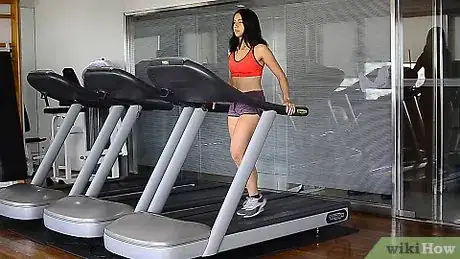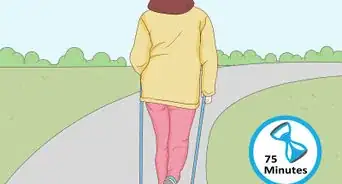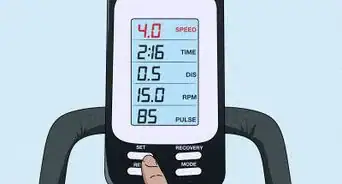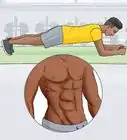This article was co-authored by Kai Ng. Kai Ng is a USATF and RRCA Certified Running Coach at Run Coach Kai. Kai has competed in over 55 races and over 15 marathons, and has trained with 16x USA and World record holder Patti Catalano Dillonso. He specializes in coaching runners of all levels and showing people that everyone can be a runner. Kai is committed to helping his clients reach their goals by showing them how to run with proper form and holding them accountable to train consistently.
There are 9 references cited in this article, which can be found at the bottom of the page.
This article has been viewed 254,259 times.
Running on a treadmill is a great form of aerobic exercise, and can help you burn calories and improve your overall health. While it might seem that a treadmill simply involves running, you should learn how to safely use one before you begin your workout. Using the proper form, knowing that your gait and stride are a little different when running on a treadmill, and using safety features will help you avoid serious injury. Finding more creative routines can help you maximize your workout and keep you engaged in your exercise plan. Make sure you talk to your doctor before beginning any exercise routine.
Steps
Getting the Most from Your Workout
-
1Warm up your joints and muscles by walking before running. Your joints and muscles work best when they're warmed up for about 5 minutes. Get your blood flowing by walking at a slow pace on a slight incline, such as at a 2% incline. This will help you avoid injuries such as muscle strains or tears.[1]
- Follow your run with a few minutes of walking to cool down.
-
2Build up your speed gradually. After warming up for a few minutes, increase your speed to a light jog. After 5 minutes, increase your speed slightly. Proceed to increase speed until your pace is a sprint, then gradually decelerate in 5 minute intervals.[2]
- Consult your treadmill's manual or talk to a trainer at your gym to learn about interval training regimens that are programmed into your machine's computer.
- Never set your speed beyond your abilities. Always underestimate your maximum speed on a treadmill to avoid injury.
- Remember that the way you run on a treadmill is a little different from how you'd normally run. Get used to how this slight change feels before sprinting.
Advertisement -
3Vary speed and distance training days. Switching up your workout routine will help you keep interest and avoid doing any damage to particular muscle groups. If you focus on speed training and you try to run at a full sprint on 1 day, focus on the distance the next. Sprint for 5 to 20 minutes on your speed day, then jog for 20 to 60 minutes on the next day. Remember to begin and end your workouts with walking to warm up and cool down.[3]
- Check your control panel, consult your manual, or talk to a gym trainer to learn about automatic terrain settings that can simulate walking over hills.
- If you live on flat land but you're training for a race or marathon that'll take place in a hilly area, using terrain training functions can be a great way to build your endurance.
-
4Avoid grabbing the handrails. Holding onto the handrails will take some of your body weight off the muscles of your legs and core. This will burn fewer calories and give you less intense of a workout. If you need to take a break, bring the belt to a stop and step off for a minute.[4]
- Don't hold onto handrails while running or sprinting, as this can put you at a greater risk of falling.
- The major exception to this rule is if you have any balance issues or special needs to take into account. Use handrails when walking to maintain your balance, and be sure to consult your doctor about any further precautions you should take.
Finding More Creative Workouts
-
1Walk with your hands above your head. Raising your arms above your head while speed walking can improve your workout and maximize the number of calories you burn. It raises your heartbeat, making your workout more challenging, and strengthens your upper-body. Try moving your arms up and down with each stride in addition to holding them above your head for an extended period of time.
-
2Add upper-body exercises to your treadmill workout. Consider including an upper-body routine with your treadmill workout by using the handrails to do chest presses and triceps presses. Turn the belt off, or step off the belt onto the treadmill's side tracks.
- Grip the front rail, setting your hands as wide as the rail's length will allow. Do a set of standing chest presses by bending your arms and bringing your upper-body close to the front rail and display panel, then push yourself back up so your arms are straight.
- Face the rear of the treadmill, extend your arms, and take hold of the handrails. Do another set of chest presses using a pushup motion.
- Do overhead tricep presses with dumbbells.
- Grab a pair of light weights, such as 3 or 5 pounds, and do biceps presses as you walk for even more upper-body strengthening.
-
3Walk sideways. When you've gotten the hang of walking normally on a treadmill, consider lateral walking exercises, or walking with a slow side shuffle. Position yourself sideways on the belt and side-step at a speed of 1 to 1.5 miles (1.6 to 2.4 km) per hour. Use a handrail as you begin your shuffle to help keep balanced.[5]
- Begin with walking on the treadmill as normal. Hold the handrail in front of you as you walk straight, then grab hold of the handrail in the direction you'll be turning. In one quick step, turn and shuffle. Practice on flat ground if you're unsure of the motion.
- Walk an equal amount of time on each side so you work your muscles evenly.
-
4Walk backwards. Start off walking normally on the treadmill. Make sure the speed is set to less than 2.5 miles (4.0 km) per hour. Turn by keeping hold of the rail on the side you're turning into as you did when you shifted into a side shuffle. Reach for the other side rail and grab hold to keep your balance as you pivot from the shuffle position to backwards walking position.
- Use a high incline setting to maximize your leg workout.
- Switch backwards and forwards walking every two minutes to mix up your routine and exercise different muscles.
-
5Consider enrolling in a class or purchasing a treadmill workout video. Check to see if there are any treadmill classes available at your local gym. If you enjoy social settings, classes can help you stay engaged in your exercise routine. If you have a treadmill at home, look into workout videos, which offer challenging and unexpected ways of using a treadmill set to a pace and order designed by a fitness professional.
Using a Treadmill Safely
-
1Consult your doctor before beginning any exercise routine. Before taking on any aerobic routine, talk to a doctor about your heart health. Ask your doctor about any limitations you should place on your workout regimen.[6] When seeking medical evaluation, consider your spine and joint health, particularly your knee and ankle joint health.[7]
- If you have low cartilage, arthritis, or other joint problems you should ask your doctor if a treadmill's belt cushioning would be hard on your joints.
- Your doctor might recommend walking on grassy or soft surfaces to prevent further joint damage.
-
2Familiarize yourself with the display, control panel, and safety features. Before using any treadmill, make sure you go over its control panel, workout options, and safety features. Seek guidance from a trainer at your gym, or if you're purchasing a treadmill for your home, consult the salesperson or other professional at the store. Locate the emergency stop button and determine whether the treadmill has a safety stop tether or clip.
-
3Use the safety clip. If your treadmill does have a safety tether or clip, always use it. This feature clips to your clothing and automatically stops the machine if you pull away from the control panel. While most people skip out on the tether, it's the best and most recommended way of avoiding serious harm when using a treadmill.[8] [9]
- If you suddenly fall, you will not be able to stop the machine using the emergency stop button, as it'll be out of your reach.
- Stopping the belt can prevent burns, abrasions, and other forms of bodily harm.
-
4Keep shoulders back, your head up, and don't look at your feet. Always use proper form when walking or running on a treadmill. Your body should be straight and upright, with your shoulders held back and chin up. Your abdominals should be tight, and your gaze should be fixed straight ahead. Don't look down at your feet.[10]
-
5Take a break from screen time.[11] One of the most common causes of treadmill-related injury is distraction due to looking at a cell phone. Consider leaving your phone elsewhere or putting it on airplane mode so you won't be tempted to answer any calls or texts. If you use your cell phone to listen to music while running, use an arm strap for hands-free use, and keep it on airplane mode.[12]
-
6Come to a complete stop. Avoid jumping off a treadmill while the belt is in motion. Instead, wait until it's come to a stop to dismount. Turn the machine off or use any available pause function if you need a break, and never jump back on a belt in motion.[13]
-
7Use your treadmill away from walls or windows. Your gym will most likely have positioned its treadmills to avoid injury in case of a fall, but you choose where you place your home machine carefully. If a treadmill is positioned too closely to a wall, you are at a greater risk of becoming pinned between the moving belt and the wall. This can result in significant bodily harm. Make sure you have 6 to 8 feet (1.8 to 2.4 m) of clearance between the rear of the treadmill and the nearest wall. Never position the rear of your treadmill close to a window or glass door, or a fall could put you at risk of colliding with the glass.[14]
- Make sure you take measurements of the area in your home where you're placing the treadmill before purchasing one.
- If you're purchasing a treadmill to use at home, go with one that has both an emergency stop button and a safety tether clip. Making sure the machine stops in the event of a sudden fall is especially important at home, since there won't be any trained professionals to offer assistance as there are at a gym.[15]
- Consider all members of your household when purchasing a treadmill. Make sure it's located in a room where you can keep young children from accessing it.
Expert Q&A
-
QuestionHow do I stay safe on a treadmill?
 Kai NgKai Ng is a USATF and RRCA Certified Running Coach at Run Coach Kai. Kai has competed in over 55 races and over 15 marathons, and has trained with 16x USA and World record holder Patti Catalano Dillonso. He specializes in coaching runners of all levels and showing people that everyone can be a runner. Kai is committed to helping his clients reach their goals by showing them how to run with proper form and holding them accountable to train consistently.
Kai NgKai Ng is a USATF and RRCA Certified Running Coach at Run Coach Kai. Kai has competed in over 55 races and over 15 marathons, and has trained with 16x USA and World record holder Patti Catalano Dillonso. He specializes in coaching runners of all levels and showing people that everyone can be a runner. Kai is committed to helping his clients reach their goals by showing them how to run with proper form and holding them accountable to train consistently.
Certified Running Coach First make sure the treadmill is in working condition. You don't want to be working out on a treadmill that malfunctions. You should also definitely use the safety clip so the treadmill stops if you fall. Some runners tend to run too far up on top of the console of the treadmill, which can actually cause you to hit and slip on the actual structure of the treadmill instead of the belt, so be careful not to do that. Run at a pace that you're comfortable with. Don't get competitive and look at people on your left or on your right. Watching TV or listening to music can sometimes can be a distraction when you're using a treadmill.
First make sure the treadmill is in working condition. You don't want to be working out on a treadmill that malfunctions. You should also definitely use the safety clip so the treadmill stops if you fall. Some runners tend to run too far up on top of the console of the treadmill, which can actually cause you to hit and slip on the actual structure of the treadmill instead of the belt, so be careful not to do that. Run at a pace that you're comfortable with. Don't get competitive and look at people on your left or on your right. Watching TV or listening to music can sometimes can be a distraction when you're using a treadmill. -
QuestionHow long can you use a treadmill?
 Michele DolanMichele Dolan is a BCRPA certified Personal Trainer in British Columbia. She has been a personal trainer and fitness instructor since 2002.
Michele DolanMichele Dolan is a BCRPA certified Personal Trainer in British Columbia. She has been a personal trainer and fitness instructor since 2002.
Certified Fitness Trainer Most treadmills at gyms are set to a maximum program length. Depending on the busy-ness of the gym, it can be 30 minutes or one hour. A good commercial treadmill can run all day. Walking on a treadmill is great exercise and there is no limit to how long is recommended for using the treadmill, however, it is better for your body to get variety in exercise, so generally speaking, one hour per session is plenty.
Most treadmills at gyms are set to a maximum program length. Depending on the busy-ness of the gym, it can be 30 minutes or one hour. A good commercial treadmill can run all day. Walking on a treadmill is great exercise and there is no limit to how long is recommended for using the treadmill, however, it is better for your body to get variety in exercise, so generally speaking, one hour per session is plenty. -
QuestionCan you lose belly fat by running on a treadmill?
 Michele DolanMichele Dolan is a BCRPA certified Personal Trainer in British Columbia. She has been a personal trainer and fitness instructor since 2002.
Michele DolanMichele Dolan is a BCRPA certified Personal Trainer in British Columbia. She has been a personal trainer and fitness instructor since 2002.
Certified Fitness Trainer Yes, running is great exercise and it burns lots of calories including fat from all over, as long as you follow a calorie reduced diet.
Yes, running is great exercise and it burns lots of calories including fat from all over, as long as you follow a calorie reduced diet.
References
- ↑ http://www.huffingtonpost.com/2013/06/05/treadmill-mistakes_n_3385564.html
- ↑ http://www.exerciseismedicine.org/assets/page_documents/Use%20A%20Treadmill%20To%20Boost%20Your%20Running%20Performance.pdf
- ↑ http://www.exerciseismedicine.org/assets/page_documents/Use%20A%20Treadmill%20To%20Boost%20Your%20Running%20Performance.pdf
- ↑ http://www.mensfitness.com/training/cardio/9-ways-max-out-your-treadmill-workout?page=2
- ↑ http://www.mensfitness.com/training/cardio/9-ways-max-out-your-treadmill-workout?page=2
- ↑ http://www.acsm.org/docs/brochures/selecting-and-effectively-using-a-home-treadmill.pdf?sfvrsn=2
- ↑ http://www.spine-health.com/wellness/exercise/treadmills-exercise-and-pain-relief
- ↑ https://www.bu.edu/articles/2015/treadmill-safety-tips
- ↑ Kai Ng. Certified Running Coach. Expert Interview. 12 February 2021.
- ↑ http://www.acsm.org/docs/brochures/selecting-and-effectively-using-a-home-treadmill.pdf?sfvrsn=2
- ↑ Kai Ng. Certified Running Coach. Expert Interview. 12 February 2021.
- ↑ https://www.washingtonpost.com/news/to-your-health/wp/2015/05/05/how-to-safely-use-a-treadmill-its-not-as-easy-as-you-think/
- ↑ http://www.consumerreports.org/cro/news/2015/02/7-steps-to-safe-treadmill-use-and-a-good-workout/index.htm
- ↑ http://www.acsm.org/docs/brochures/selecting-and-effectively-using-a-home-treadmill.pdf?sfvrsn=2
- ↑ http://www.acsm.org/docs/brochures/selecting-and-effectively-using-a-home-treadmill.pdf?sfvrsn=2
About This Article
To use a treadmill safely and effectively, start by familiarizing yourself with the display and control panel, and consider using the safety clip until you get comfortable with the machine. Next, start walking at a slow pace on a slight incline to warm up your joints and muscles. Be sure to keep your shoulders back, your head up, and avoid looking at your feet. Then, gradually build up your speed in 5-minute intervals. For tips on varying your workouts to maximize benefits, read on!



































































